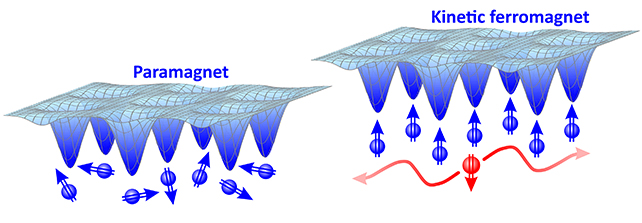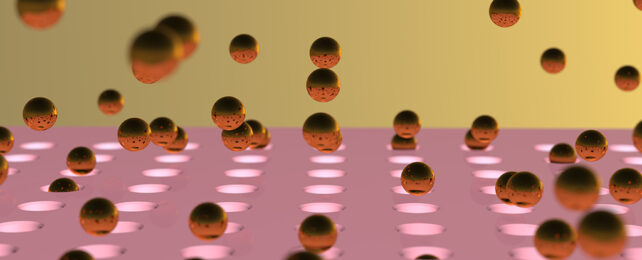More than half a century ago, Japanese physicist Yosuke Nagaoka theorized a way a magnetic field might expand from meandering electrons restlessly searching for a place to rest that was radically different from conventional models of ferromagnetism.
A phenomenon recently observed in a stack of alternating semiconductors could be explained by Nagaoka's speculations, while throwing out a few unforeseen surprises.
In an experiment led by researchers from ETH Zürich in Switzerland, atomically thin grids of two different synthetic materials were superimposed like pages in the world's thinnest book to create a repeating effect known as a moiré pattern.
"Such moiré materials have attracted great interest in recent years, as they can be used to investigate quantum effects of strongly interacting electrons very well," explains study senior author and physicist Ataç Imamoğlu.
"However, so far very little was known about their magnetic properties."
Magnetism is the team effort of numerous electrons arranging themselves under a quantum contract dictated by a property called spin.
Unlike the rotation of a ball, an electron's spin is a binary characteristic. It's never fast or slow, only ever up or down. Or, if you imagine them as tiny magnets, north or south.
Arrange enough of those tiny magnets so that their spins align; their collective behavior will allow something like an ordinary lump of iron to stick your niece's drawing of a smiling daffodil to the fridge door.
That agreement on which way to align comes courtesy of an interaction between electrons sitting calmly in their atom's back row seats. Quantum law dictates electrons with the same spin really ought to stay far away from one another, which, under the right circumstances, creates a pattern that magnifies their magnetism.
In the 1960s, Nagaoka realized a similar kind of arrangement just might form through a completely different agreement, one determined not by exchanges based on the electrons' spins but by their wanderlust.
He imagined a grid, not unlike a cityscape populated by electrons sitting at street corners like eager buskers. Leave just one corner vacant, he realized, and electrons would move, keen to find a space as far from the other quantum buskers as they could. Each jump would leave a new vacancy, causing a 'hole' to jump from street to street.
Guided by this kinetic effect of empty street corners, the same large-scale effect of spins might emerge, generating a more exaggerated magnetic field.
It's an effect that has since been seen among a tiny handful of electrons. Yet until now, nobody had observed Nagaoka's 'kinetic' magnetism emerging in a material en masse.
"Up to now, such mechanisms for kinetic magnetism have only been detected in model systems, for example in four coupled quantum dots, but never in extended solid state systems like the one we use," says Imamoğlu.
That system comprised six layers of two different semiconductors: molybdenum diselenide and tungsten disulfide. Similar to Nagaoka's grids, each could be stacked on top of one another in a way that created 'street corners' from the moiré effect of spaces between the layers.
Once the thin layers had been cooled right down to remove as much thermal jiggling as possible, a voltage was applied to send in a trickle of electrons.
Sure enough, each busker found a street corner to pluck out their special brand of spin. Yet unlike what Nagaoka imagined, magnetism only appeared once there was a significant surplus of electrons.
Rather than being lured into a magnetic harmony by the promise of empty spaces, it was the competition for a harmonious place to play that generated short-lived dual-acts known as doublons.

Enough of these partnerships blinking in and out caused the material to become magnetic in a way physicists had never seen before.
While the process is unlikely to lead to any new technology (or ways of holding daffodil drawings to fridges) any time soon, it does give researchers insights into behaviors that could inform the electronics of the future.
This research was published in Nature.
